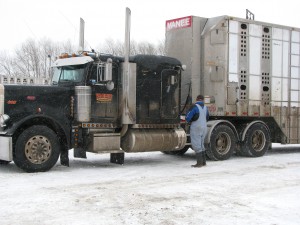 The Canadian Food Inspection Agency (CFIA) is currently in the process of revising existing regulations on the transport of animals, which have not been substantially updated since 1975. However, industry practices have changed considerably since then and new scientific research has given us a better understanding of what is required to ensure the humane treatment of animals during transport.
The Canadian Food Inspection Agency (CFIA) is currently in the process of revising existing regulations on the transport of animals, which have not been substantially updated since 1975. However, industry practices have changed considerably since then and new scientific research has given us a better understanding of what is required to ensure the humane treatment of animals during transport.
The World Organization for Animal Health will also soon adopt the first ever global standards for the transport of live animals, including pigs. Ensuring that transport industry standards meet international norms is critical for a country like Canada which exports about half its annual production – including nearly 10 million live hogs a year.
 Drs. Al Schaefer and Clover Bench, Agriculture and Agri-Food Canada scientists in Lacombe, Alberta have been coordinators of a review of the existing recommendations, standards, laws and regulations on pig welfare during transport, to compare them with current scientific literature that started in 2005. This review will help ensure the upcoming changes to Canada’s Livestock Transport Code of Practice are based on scientific data to improve the welfare of animals and, subsequently, maintain or improve meat quality.
Drs. Al Schaefer and Clover Bench, Agriculture and Agri-Food Canada scientists in Lacombe, Alberta have been coordinators of a review of the existing recommendations, standards, laws and regulations on pig welfare during transport, to compare them with current scientific literature that started in 2005. This review will help ensure the upcoming changes to Canada’s Livestock Transport Code of Practice are based on scientific data to improve the welfare of animals and, subsequently, maintain or improve meat quality.
“The events that affect animals, like transport stress, are linked directly to actual outcomes in meat quality, food safety and animal welfare,” notes Dr. Schaefer. “Stress causes a number of physical changes in precisely the things that affect food flavour and quality.”
His team specifically examined loading density and journey duration standards (including rest periods and the supply of food and water) in The Recommended Code of Practice for the Care and Handling of Farm Animals –Transportation and the Canadian Health of Animals Act. The review also examined recommendations and regulations in a number of other countries, including the USA, Australia, Ireland, the UK and other EU countries.
Loading density standards
At lower space allowances, pigs encounter higher ambient temperatures, decreased ventilation and air quality, as well as insufficient space to lie down in transit. At the other end of the spectrum, increased space allowance reduces vehicle temperature and increases ventilation, but it can also increase the incidence of fighting and aggression in transit.
Overcrowding can result in increased mortality rates, food safety concerns, and reduced meat quality (primarily the incidence of pale-soft-exudative (PSE) meat). Space allowances above 0.45-0.5 m2/100 kg pig can increase skin damage and the incidence of dark-firm-dry (DFD) meat.
Proper pig density can offset the effects of high temperatures by providing adequate ventilation through vehicle vents, regulating heat production within the vehicle, and providing animals with adequate space to accommodate their size, behaviour and positions during transport.
“The effect of extremely hot and extremely cold conditions during transport and its effect on loading density also needs to be studied in greater detail,” say Dr. Schaefer. “This is of particular importance in Canada due to the extremes in temperature which are experienced throughout the country and over the course of a year.”
Travel duration
The scientific literature has yet to reach a consensus on maximum transport times or the precise impact of rest periods during transport, both of which can affect meat, points out Dr. Schaefer. In fact, he says, there is one school of thought that says short journeys may be more detrimental – for instance higher mortality rates due to animals being unable to adjust to transport stress – than for longer ones and every effort to attenuate such stress during short transport journeys should be made.
The loading and unloading of animals is the most stressful component of livestock transport. Unloading animals for rest periods mid-transport may increase the stress experienced by transported animals. “Research on loading and unloading during long distance travel and the methods used to load and unload animals is urgently needed from the point of view of animal welfare and meat quality,” says Dr. Bench. “Further studies need to determine if it would be better to allow animals to remain on the transport truck and continue their journey, with access to food and water on a ‘higher standard’ vehicle, or if it would be better to transport them shorter distances on a ‘basic’ vehicle and unload them for a rest period with access to food and water.”
“As consumers globally increasingly demand higher standards for the welfare of animals both in their rearing and transport, we must maintain the highest standards of animal welfare or risk losing market share to countries that have implemented increasingly rigorous regulations,” concludes Dr. Schaefer.
Photo captions:
Al Schaefer – Al Schaefer, from Lacombe Research Station, one of the authors of the transport review
Trucking pigs – Livestock transport practices have changed and regulations are in need of updating









